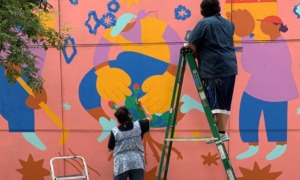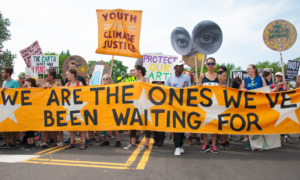
spixel/Shutterstock
.
Half a century ago, as the Vietnam War still raged, President Nixon began bombing neighboring Cambodia — without bothering to mention it to Congress or the American people. After the New York Times found out about it, this became known as the “secret bombing” of Cambodia
But as Garry Trudeau pointed out in “Doonesbury” four years later, it wasn’t a secret to the Cambodians. “Secret bombings?” a Cambodian says. “Boy, there wasn’t any secret about them. Everyone here knew. I did. And my wife, she knew too! She was with me, and I remarked on them.”
I think of this whenever people in child welfare declare themselves shocked by something that everyone who has to deal with child protective services already knows. The latest case in point: a commentary for a medical journal by Dr. Katherine Campbell, a professor of pediatrics at the University of Utah. The headline reads: “Prevention of Child Maltreatment as an Unexpected Benefit of Social Policies.”

Richard Wexler
“Unexpected”? Not for those who are poor or ever have been poor. I suspect they’d say: “It’s not unexpected to us. We remarked on it.”
The commentary concerns a study that found that reports of what child protective services agencies deem “neglect” declined in states that took advantage of the option to expand Medicaid under the Affordable Care Act, and increased in states that did not take advantage of this option.
The commentary notes that the study does not explain why expanding Medicaid coverage was followed by reduced “neglect.” The authors of the study appear puzzled by this. But it should be puzzling only to those who have built their careers on misunderstanding child maltreatment.
For the rest of us it’s pretty obvious: “Medical neglect” is, itself, a category of child neglect. Odds are if people have health insurance, they’re more likely to be able to get health care for their children. More generally, lower health costs for poor families means more money for food clothing and shelter — the lack of which also are routinely confused with neglect.
It’s not as if this is the first study of its kind.
WHAT THE RESEARCH TELLS US
There’s the study that found that if you raise the minimum wage by $1, you cut the rate of what agencies call child “neglect” by 10%. In this case, however, the researchers had no problem figuring out why.
There’s the study that found that increasing the earned income tax credit by $1,000 per year cuts the likelihood of child protective services involvement by 7 to 10%.
There’s the study that found that increasing income by only $100 reduces the likelihood of a “child maltreatment” report by two percentage points.
There’s what happened when Native American families, already part of a study, received an unexpected windfall from casino revenue: $4,000 more per person per year. Surprise! Child well-being significantly improved.
And then there’s this: Multiple studies have found that 30% of America’s foster children could be home right now if their parents just had decent housing. But what should we do about it? A massive study found that when homeless families received housing vouchers the rate at which they lost children to foster care was cut by half.
That, of course, should be obvious. But the study also found that when the housing vouchers were accompanied by inflicting social work on the families, the results were not nearly as good.
And yet, over and over, people in child welfare pronounce themselves surprised and deem these benefits “unexpected.” That’s because these findings refute not only America’s conventional wisdom about child welfare but the conventional wisdom about a host of other social problems.
MYTHS OF LEFT AND RIGHT
The results shatter myths cherished by the left and the right.
Many on the right have been telling us for decades that poverty is a moral failing, poor people are lazy and providing them help only promotes “dependence.” In fact, it’s harder to imagine a more difficult job than surviving while poor in America.
Many on the left hold similar views, but they sugarcoat them by saying it’s not actually poor people’s fault. All that “past” oppression supposedly makes them unable to cope without lots and lots of counseling and parent education. In other words: They’re not evil, they’re just sick! Good thing we’re there to help! But, as these studies, especially the one on housing, make clear, often this kind of “help” doesn’t help.
Professor Emerita Barbara Nelson has written that the quintessential American view of any social problem is that it is “individually rooted, described as an illness, and solvable by occasional doses of therapeutic intervention.” She wrote this in a book explaining how and why the real causes of child abuse and neglect were ignored when Congress passed the Child Abuse Prevention and Treatment Act, a law that codified all our mistakes and haunts us to this day.
This framing is appealing to the right because it means nothing about child abuse is our fault. It appeals to the left for reasons aptly described by Malcolm Bush in his book “Families in Distress”:
“The recognition that the troubled family inhabits a context that is relevant to its problems suggests the possibility that the solution involves some humble tasks … This possibility is at odds with professional status. Professional status is not necessary for humble tasks … Changing the psyche was a grand task, and while the elaboration of theories past their practical benefit would not help families in trouble, it would allow social workers to hold up their heads in the professional meeting or the academic seminar.”
In another article, Bush uses a typical case record to illustrate how the system is geared to helping the helpers. The record said this:
“This is a rather immature, impulse-ridden boy who does, however, respond to predictable external controls. The inability to control rather primitive aggressive impulses unless he were exposed to an understanding but firm and neutral environment does indicate the need for placement in a boarding school with reality-oriented rewards for acceptable functioning and immediate delivery of negative reinforcement for unacceptable aspects of his behavior.”
Bush then translates:
“The boy behaves badly, needs to be praised when he does well and punished when he misbehaves. [But] The common language description of the problem … could put the solution in the hands of non-professionals … [Using therapeutic jargon] reduces this possibility and steers the boy to the specialized services of the private agency.”
All this has profound implications for two of the most prominent initiatives in child welfare today:
TAKE FAMILY FIRST — PLEASE
In its earliest iterations, what is now the vastly overhyped Family First Prevention Services Act would have allowed states to use money now reserved for foster care on concrete help to ameliorate the worst aspects of poverty. But early on that was stripped out of the bill. In its final form, the bill allows the use of these funds for only three types of services. One of them — substance abuse treatment — is genuinely useful. The others are mental health services (because remember: If you’re poor you must be mentally ill!) and home-based programs emphasizing counseling and parent education.
So the primary purpose of this part of Family First has become making the helpers feel good and keeping an industry of “providers” in business.
A WASTE OF ALGORITHMS
One of the rationalizations from some of those who want to use “predictive analytics” algorithms that supposedly predict who is likely to abuse a child to target families for any number of interventions goes like this: “We’ll only use it to target prevention, so we can spend our money more wisely.” But narrowing the range of what is done and to whom it’s done probably is the worst thing one can do.
As Dr. Campbell writes:
“What if the most effective, efficient, and sustained approach to preventing child maltreatment is the adoption of policies that broadly improve social equity and public health, rather than the implementation of programs that specifically target child maltreatment prevention? … [There is] growing evidence that prevention of and protection from child maltreatment may be best achieved through social policies that will support all members of our communities.”
We already know exactly how to target child abuse prevention without an algorithm. It’s a simple, two-step process.
- Find the neighborhoods where poor people live.
- Send money.
Now that would be — unexpected.
Richard Wexler is executive director of the National Coalition for Child Protection Reform,































